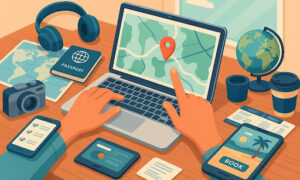Introduction
In the realm of travel, two terms often interchangeably used but distinctly different in roles are “tour guide” and “tourist guide.” While the nuances might seem subtle, understanding the disparity is crucial for both seasoned travelers and those embarking on their first journey. This comprehensive guide aims to unravel the distinctions, shedding light on the unique responsibilities, skill sets, and contributions that tour guides and tourist guides bring to the world of exploration.
I. Defining the Roles:
A. Tour Guide:
Responsibilities:
Tour guides are individuals responsible for leading groups of travelers through various attractions and providing historical and cultural insights. Their primary role is to enhance the overall travel experience by offering in-depth knowledge about the destination, ensuring a seamless and enriching journey.
1. Expertise:
A tour guide’s expertise spans a wide range, from historical facts and local traditions to geography and architecture. They act as storytellers, weaving narratives that captivate the audience and provide a deeper understanding of the places visited.
2. Communication Skills:
Effective communication is paramount for tour guides. They must convey information clearly, engage their audience, and adapt their communication style to accommodate diverse groups with varying interests and backgrounds.
B. Tourist Guide:
Responsibilities:
Tourist guides, on the other hand, play a more personalized role, catering to the needs of individual travelers or small groups. Their responsibilities extend beyond narration, encompassing assistance with logistics, cultural integration, and ensuring the well-being of their clients.
1. Expertise:
While a tourist guide possesses extensive knowledge of the destination, their expertise also includes navigating practical aspects like transportation, accommodation, and local customs. They often act as companions, offering insights that go beyond historical and cultural facets.
2. Communication Skills:
Similar to tour guides, effective communication is vital for tourist guides. However, they emphasize building a rapport with individual clients and tailoring their guidance to meet specific interests and preferences.
II. Educational Background and Certification:
A. Tour Guide:
1. Educational Background:
Many tour guides undergo formal education in fields like history, archaeology, or cultural studies to equip themselves with the knowledge needed for their role. Additionally, language proficiency is often a prerequisite, as they cater to a diverse array of tourists.
2. Certifications:
Obtaining certifications from reputable tourism associations or institutions is common for tour guides. These certifications validate their expertise and commitment to maintaining high standards in the industry.
B. Tourist Guide:
1. Educational Background:
Tourist guides often possess a broader educational background, which may include hospitality, tourism management, or even languages. This diverse knowledge base allows them to address the multifaceted needs of individual travelers.
2. Certifications:
While certifications specific to tourist guiding exist, individuals in this role may also hold certifications in areas such as customer service, travel planning, or crisis management. This diverse skill set enhances their ability to provide comprehensive support.
III. Tailoring Experiences:
A. Tour Guide:
1. Group Dynamics:
Tour guides excel at managing group dynamics, fostering a sense of camaraderie among travelers. They coordinate activities, answer questions, and ensure everyone feels included in the exploration.
2. Fixed Itineraries:
Tours led by guides often follow pre-established itineraries, offering a structured and efficient way to explore a destination. This approach is beneficial for travelers seeking a well-organized and informative experience.
B. Tourist Guide:
1. Personalized Experiences:
Tourist guides thrive on tailoring experiences to the individual preferences of their clients. Whether it’s focusing on specific interests, adjusting the pace of exploration, or recommending hidden gems, they prioritize personalized journeys.
2. Flexibility:
The flexibility inherent in tourist guiding allows for spontaneous detours and adjustments to itineraries based on the client’s desires. This adaptability is particularly appealing to those who prefer a more customized travel experience.
IV. The Global Impact of Guides:
A. Tour Guide:
1. Preserving Cultural Heritage:
Tour guides play a pivotal role in preserving and promoting the cultural heritage of a destination. Their narratives contribute to a greater understanding and appreciation of historical significance, fostering cultural preservation.
2. Economic Impact:
By attracting tourists to specific sites and destinations, tour guides contribute significantly to the local economy. They play a key role in sustaining tourism-related businesses and promoting sustainable travel practices.
B. Tourist Guide:
1. Cultural Exchange:
Tourist guides act as ambassadors for cultural exchange, facilitating meaningful interactions between travelers and locals. This personal connection enhances the overall travel experience, fostering a deeper appreciation for diverse cultures.
2. Supporting local businesses:
In addition to contributing to the local economy, tourist guides actively support small businesses and local artisans. Their recommendations often lead travelers to authentic, off-the-beaten-path establishments, promoting a more immersive and ethical form of tourism.
V. Challenges and Solutions:
A. Tour Guide:
1. Handling Diverse Groups:
Tour guides face the challenge of managing diverse groups with varying interests, energy levels, and cultural backgrounds. Effective communication, adaptability, and interpersonal skills are crucial to overcoming these challenges.
2. Keeping information fresh:
Given the repetitive nature of guiding, tour guides must continually update their knowledge and find innovative ways to present information to keep their narratives engaging and informative.
B. Tourist Guide:
1. Ensuring Personalized Service:
The main challenge for tourist guides lies in tailoring their services to meet individual client expectations. This requires a keen understanding of client preferences, effective communication, and the ability to adapt to diverse personalities.
2. Logistical Challenges:
Managing logistics for individual travelers can be complex, especially when unexpected issues arise. Tourist guides must possess problem-solving skills to navigate challenges such as transportation hiccups, accommodation concerns, or unforeseen changes to the itinerary.
VI. The Future of Guiding:
A. Technological Advancements:
1. Digital Guides and Augmented Reality:
The integration of technology, such as digital guides and augmented reality, is becoming prevalent in both tour and tourist guides. These innovations enhance the overall experience, providing real-time information and interactive elements.
2. Remote Guiding:
The rise of remote work and virtual experiences has paved the way for remote guiding. Tour guides can connect with audiences worldwide by offering virtual tours and cultural experiences, expanding their reach beyond physical boundaries.
B. Sustainable and Responsible Tourism:
1. Educating Travelers:
Guides, irrespective of their role, are becoming advocates for responsible and sustainable tourism. Educating travelers about the environmental and cultural impact of their choices fosters a more conscientious approach to exploration.
2. Community Involvement:
Guides are increasingly involved in community-based tourism initiatives, promoting interactions with local communities and supporting initiatives that prioritize environmental conservation and cultural preservation.
Conclusion
In the intricate tapestry of global travel, the roles of tour guides and tourist guides are integral threads, each weaving a unique narrative that contributes to the vibrant mosaic of exploration. While the distinctions between the two may be subtle, understanding their respective contributions enhances our appreciation for the diverse ways in which these guides shape our travel experiences. As the travel landscape continues to evolve, so too will the roles of these guides, ensuring that future journeys are not only enriching for travelers but also sustainable and impactful for the destinations they explore.



































